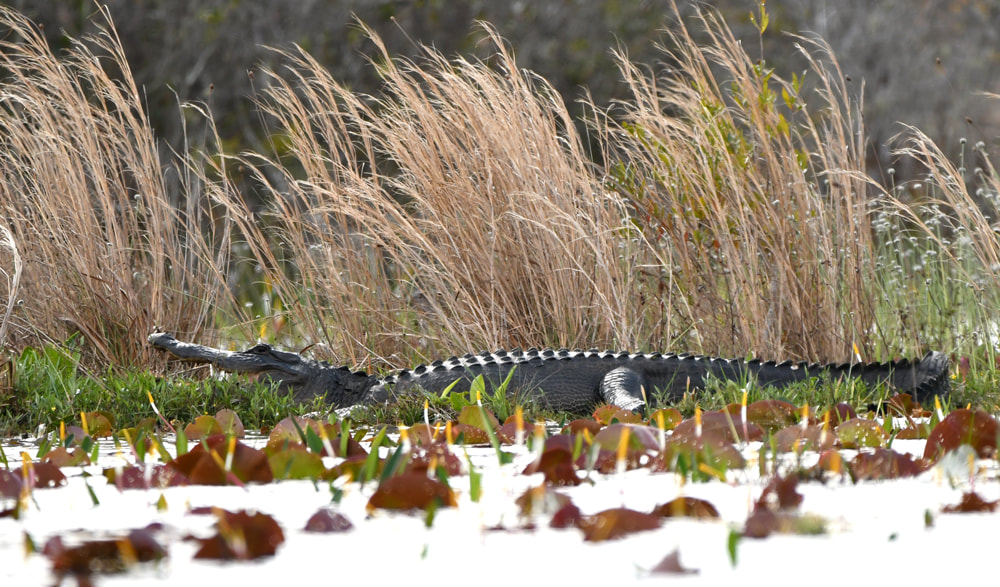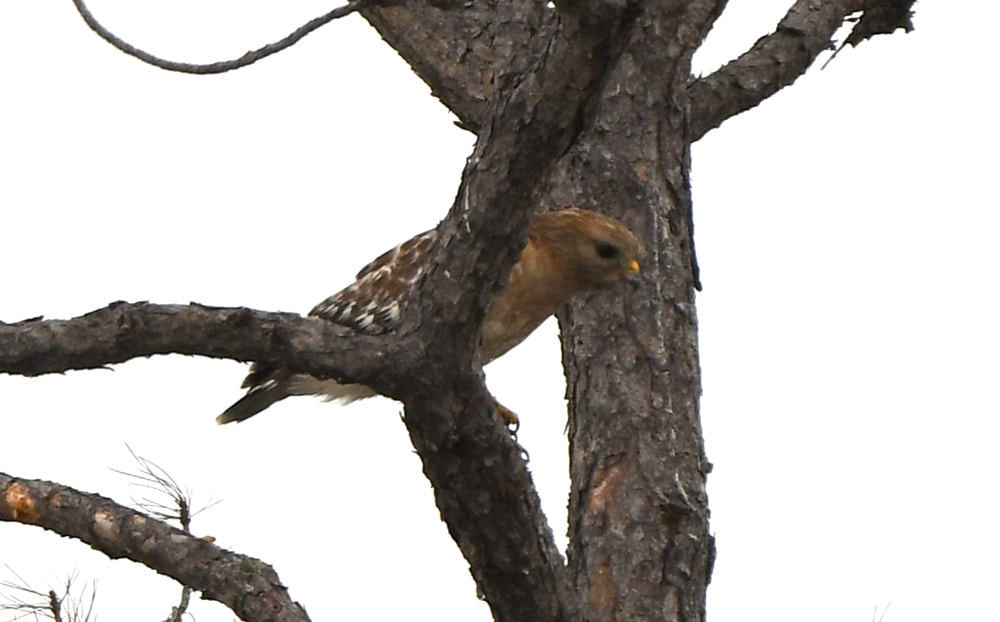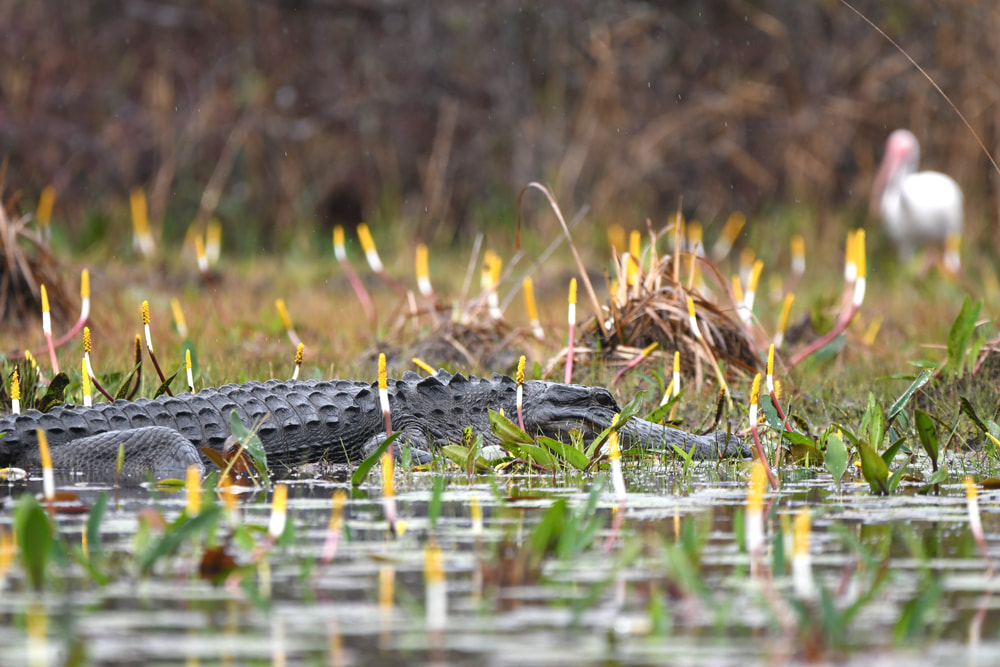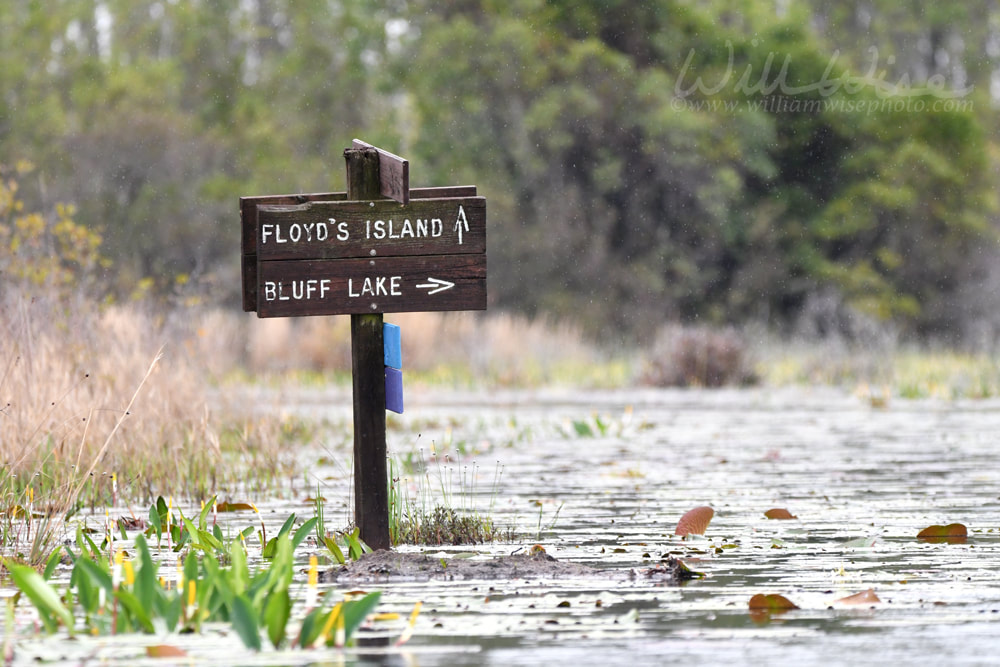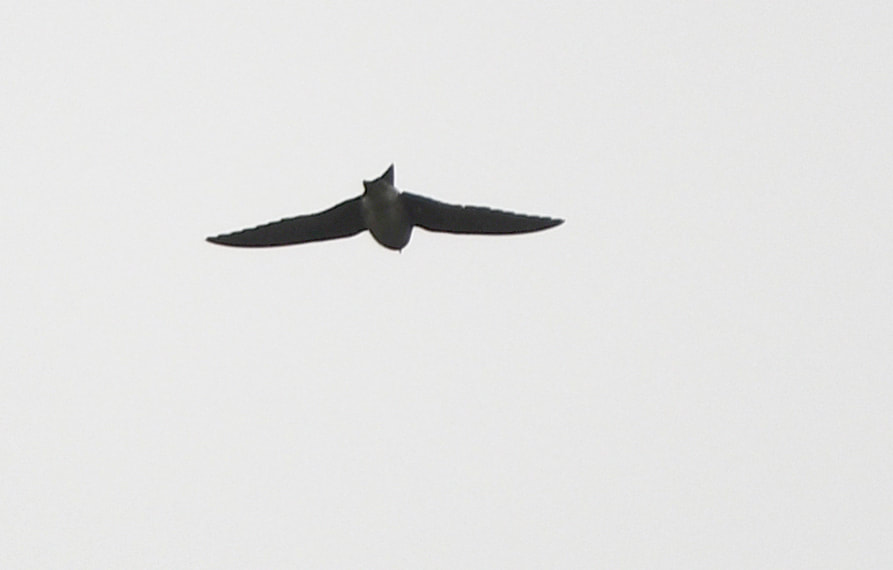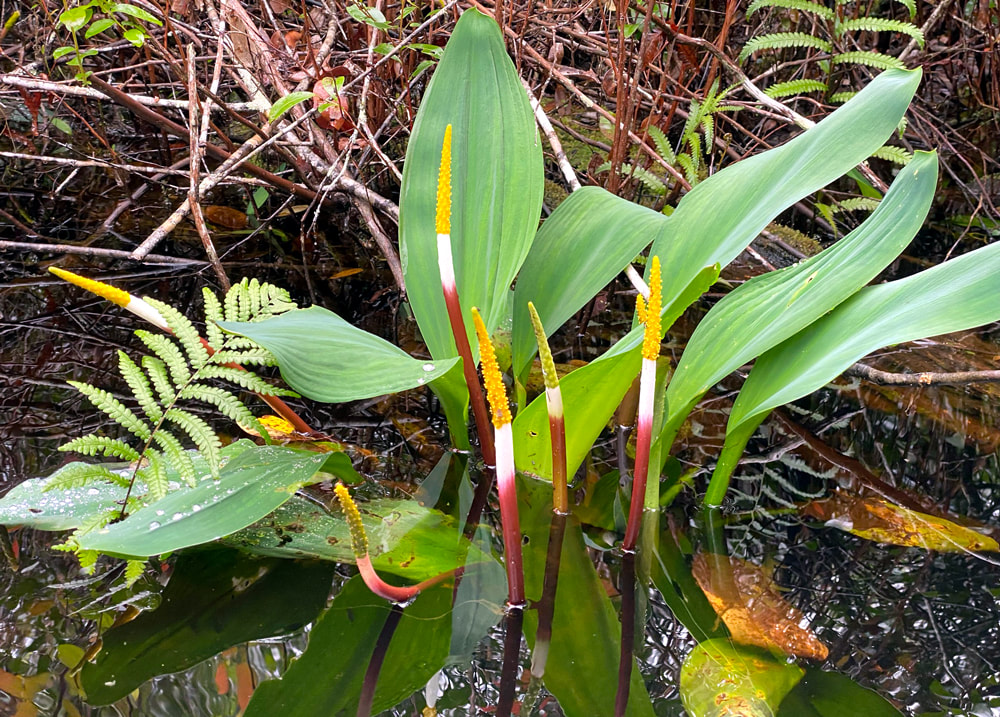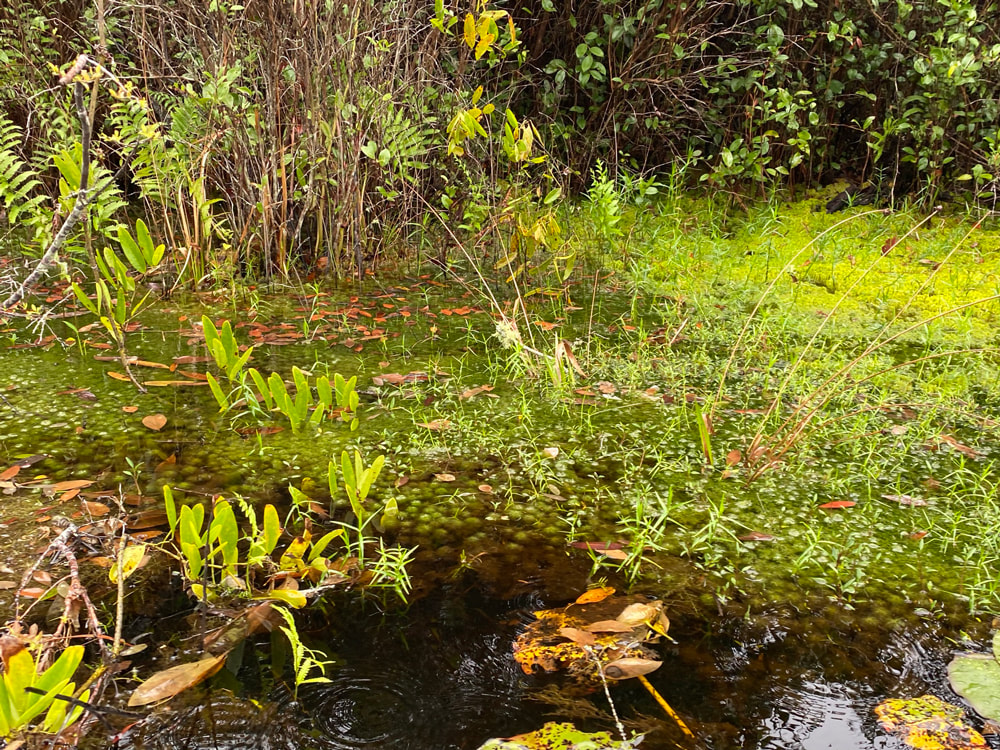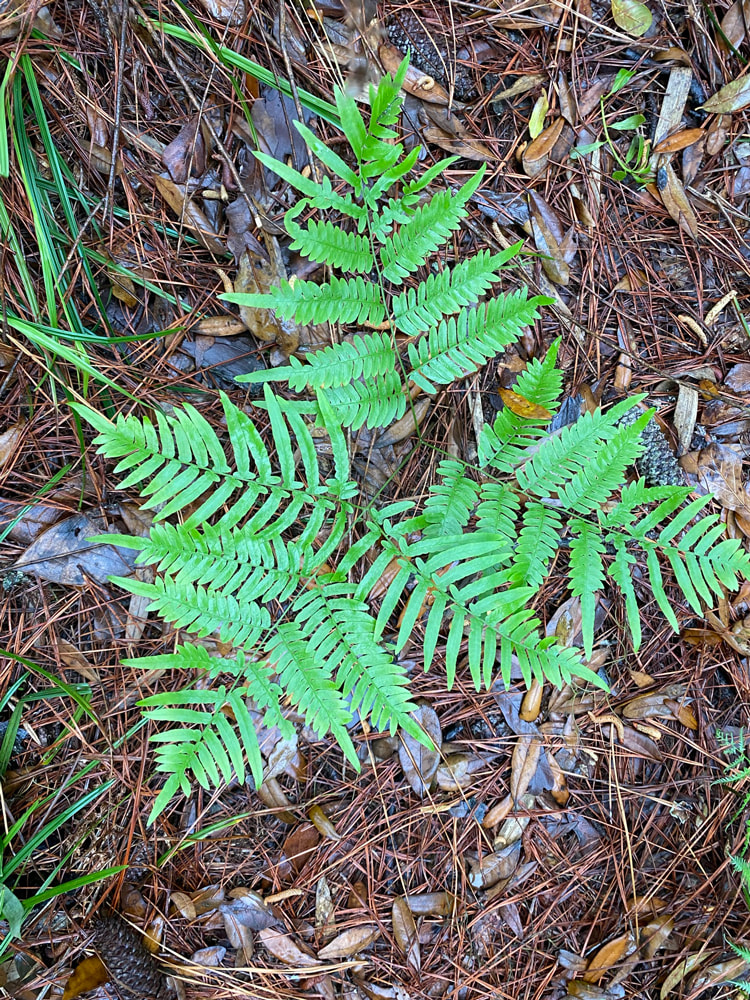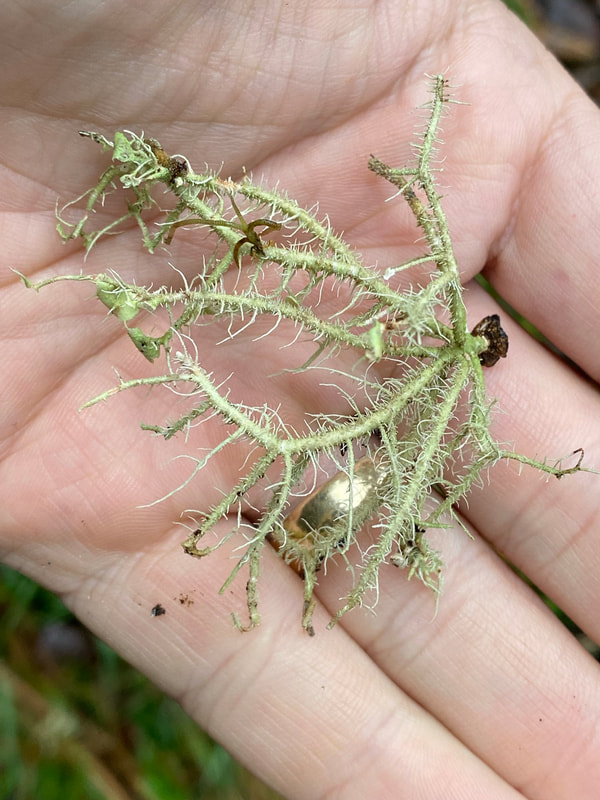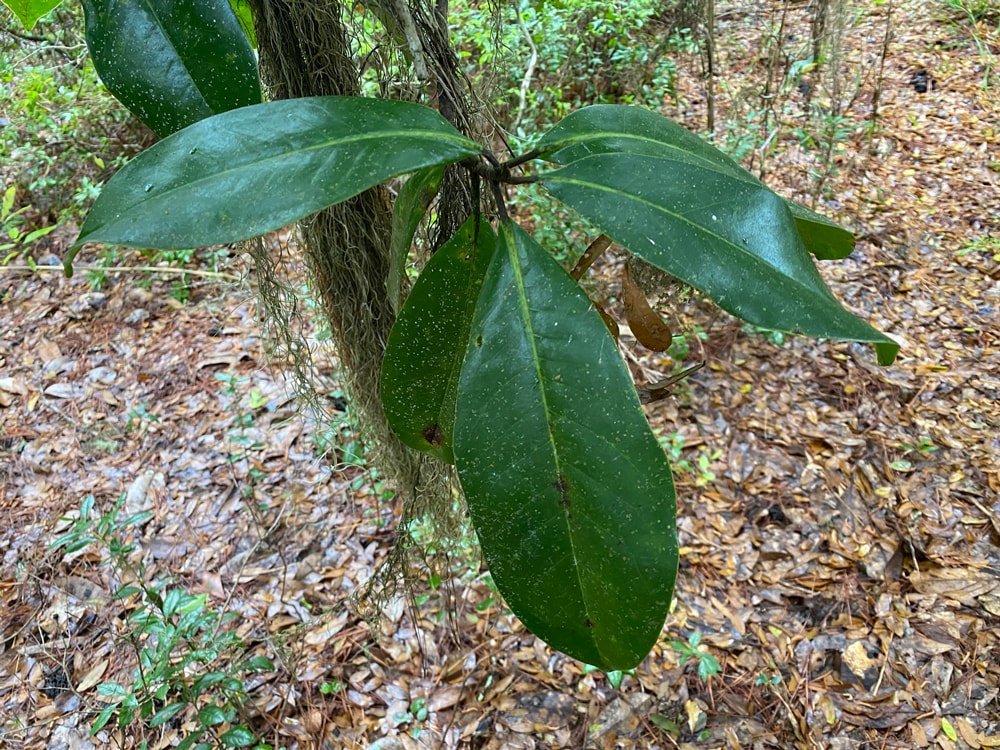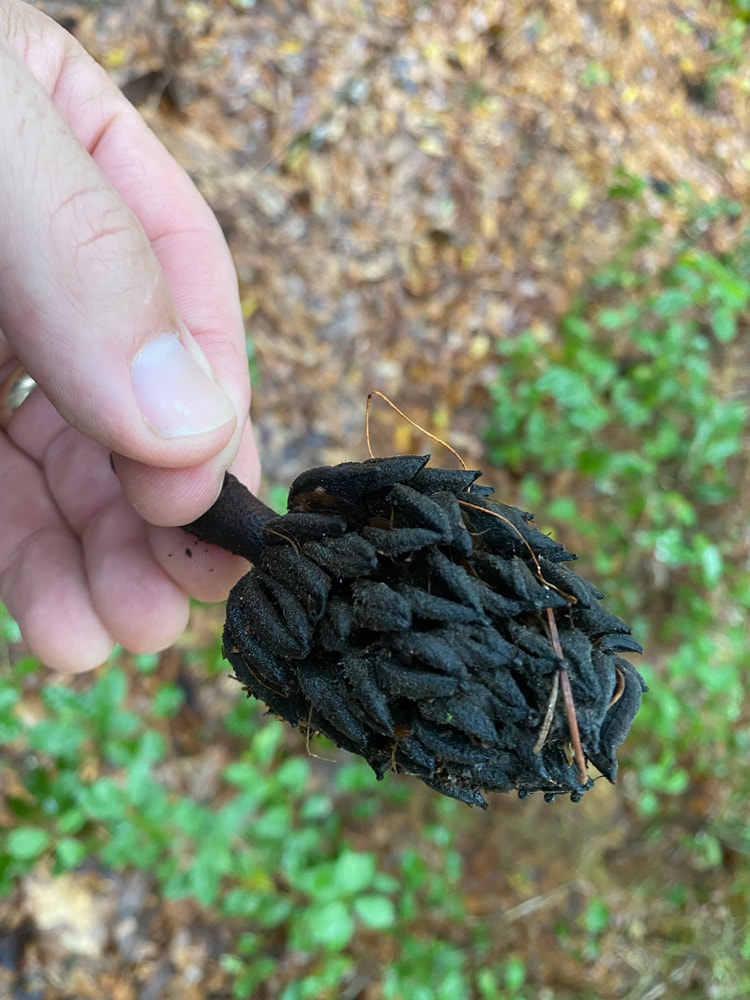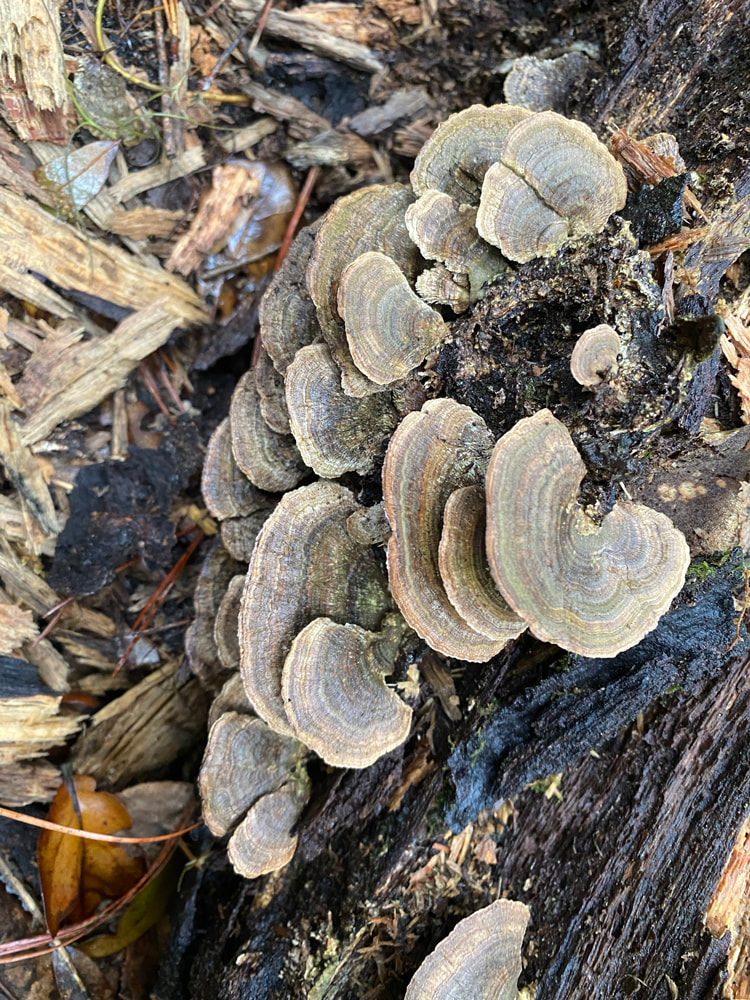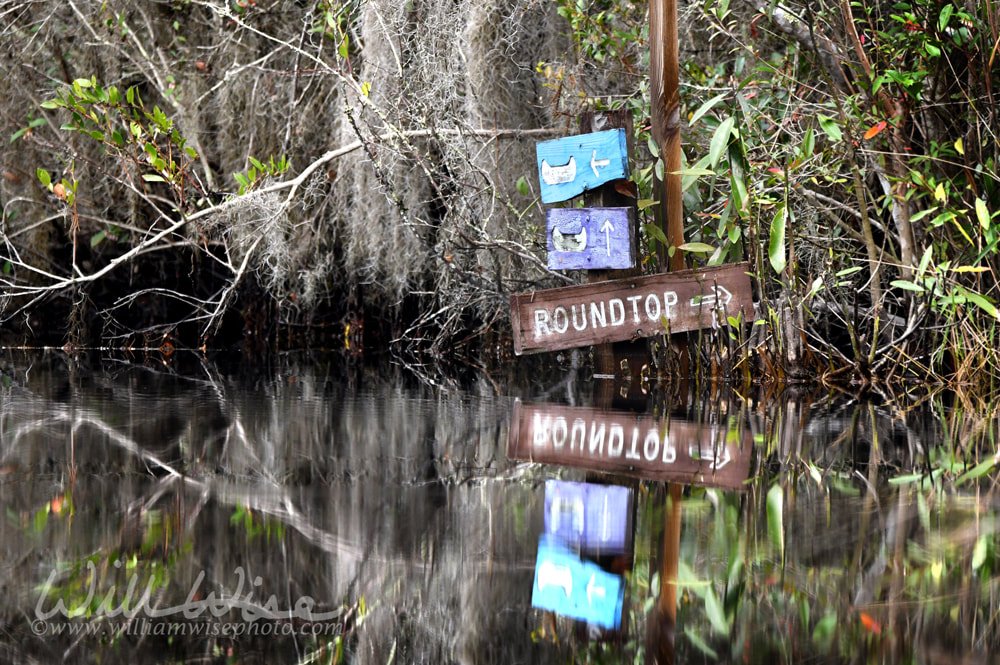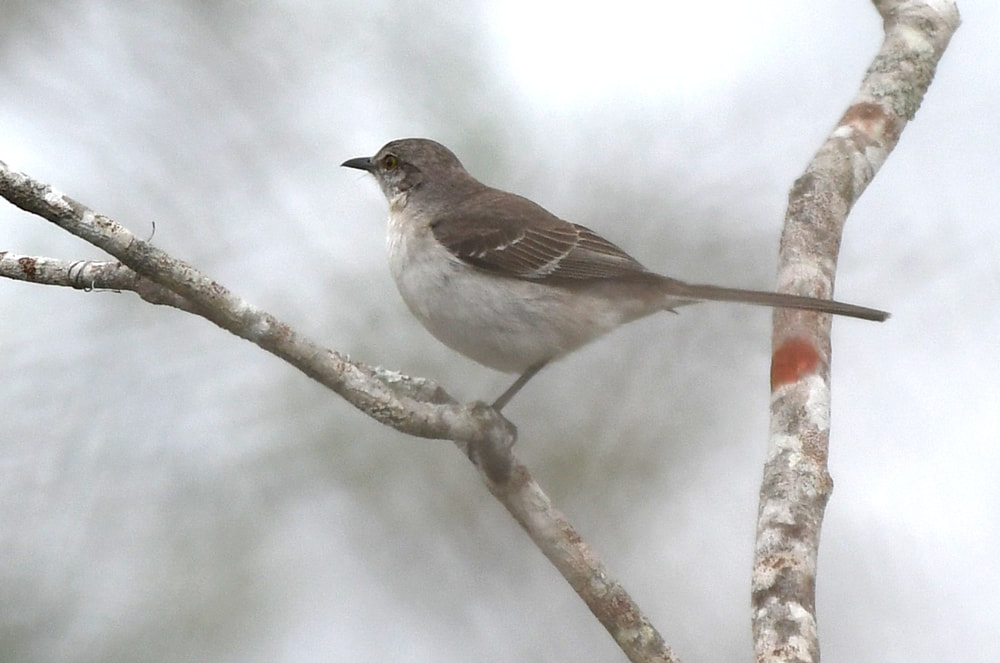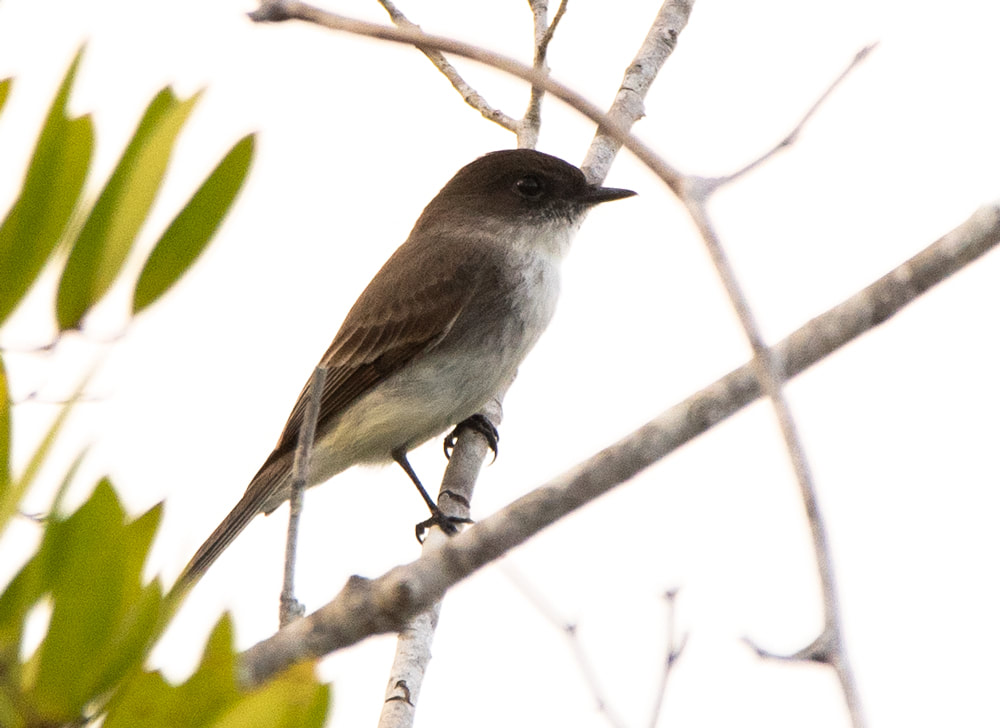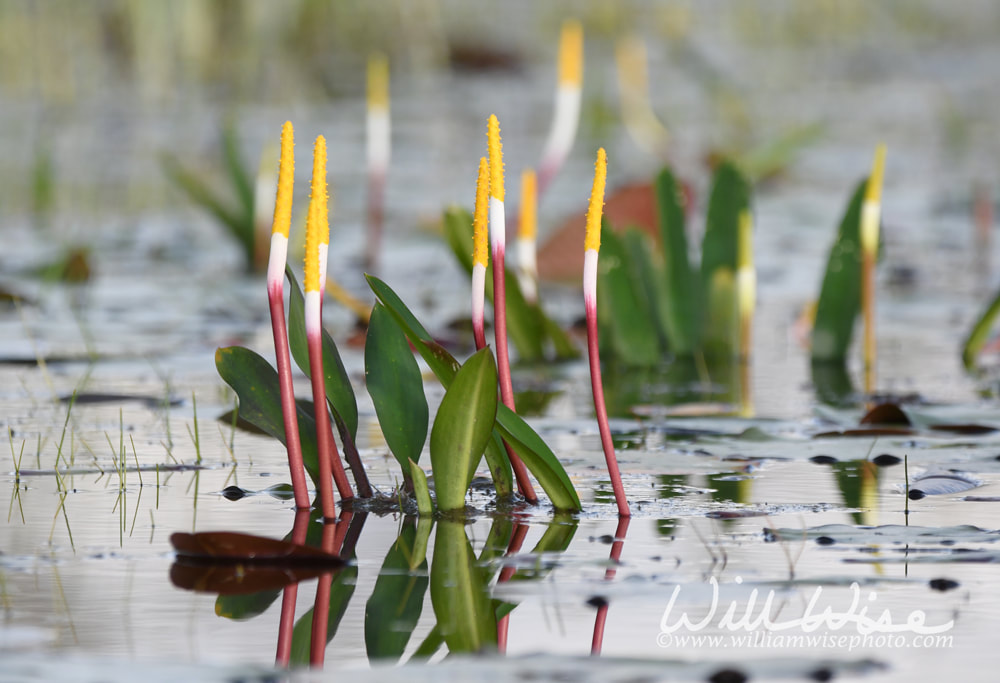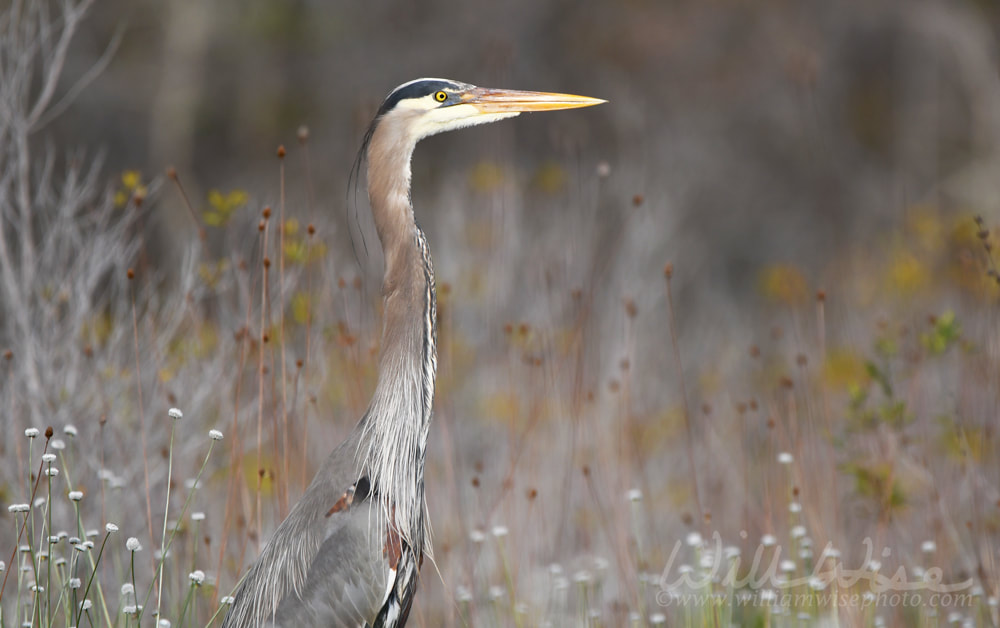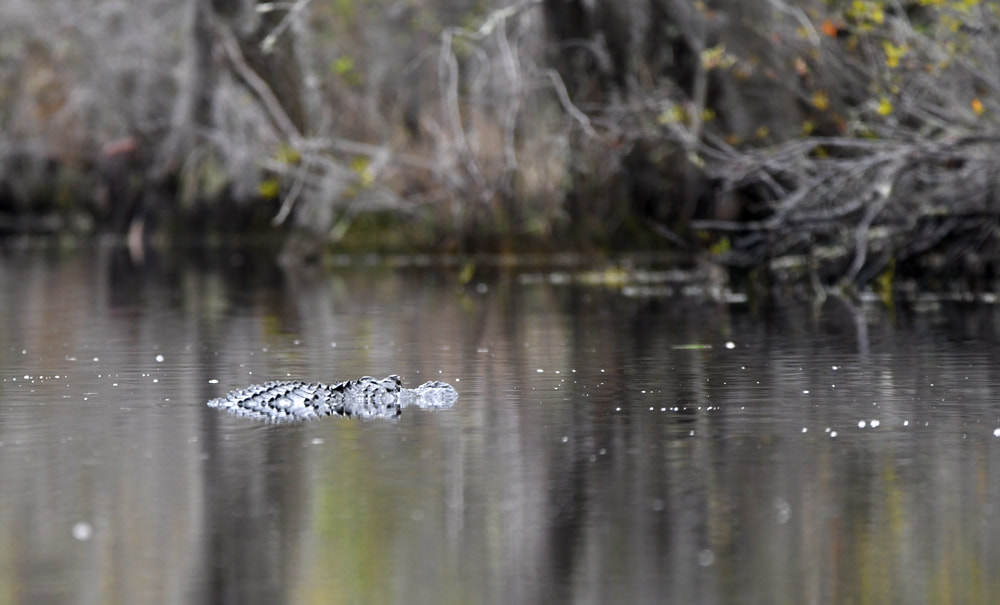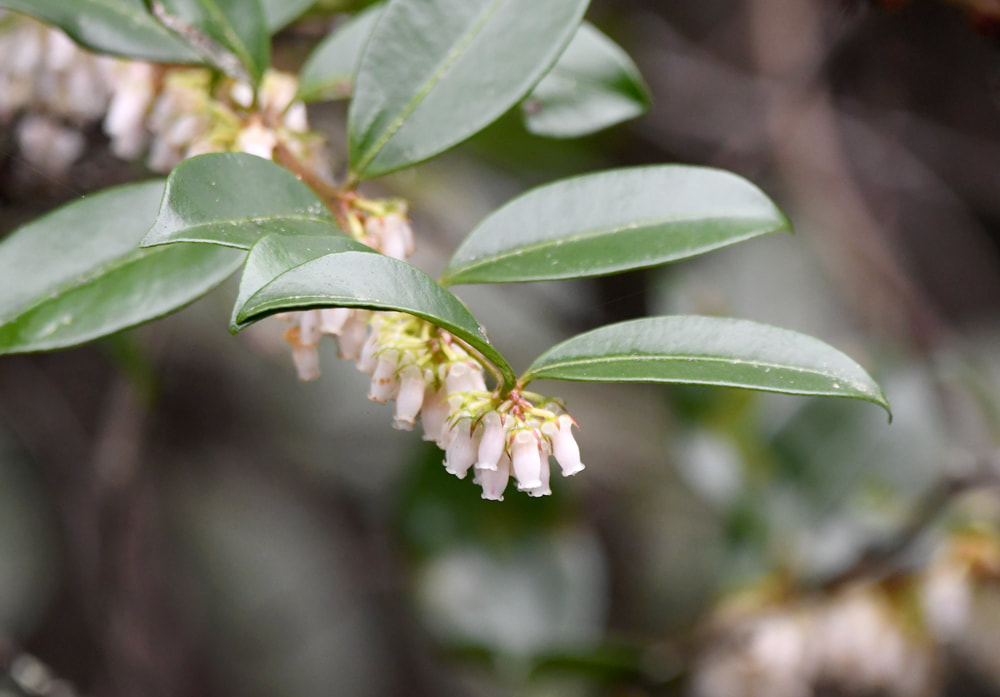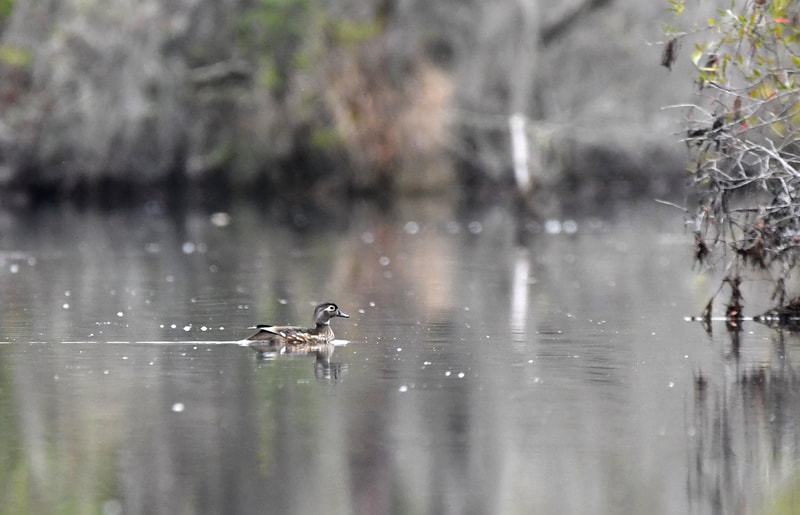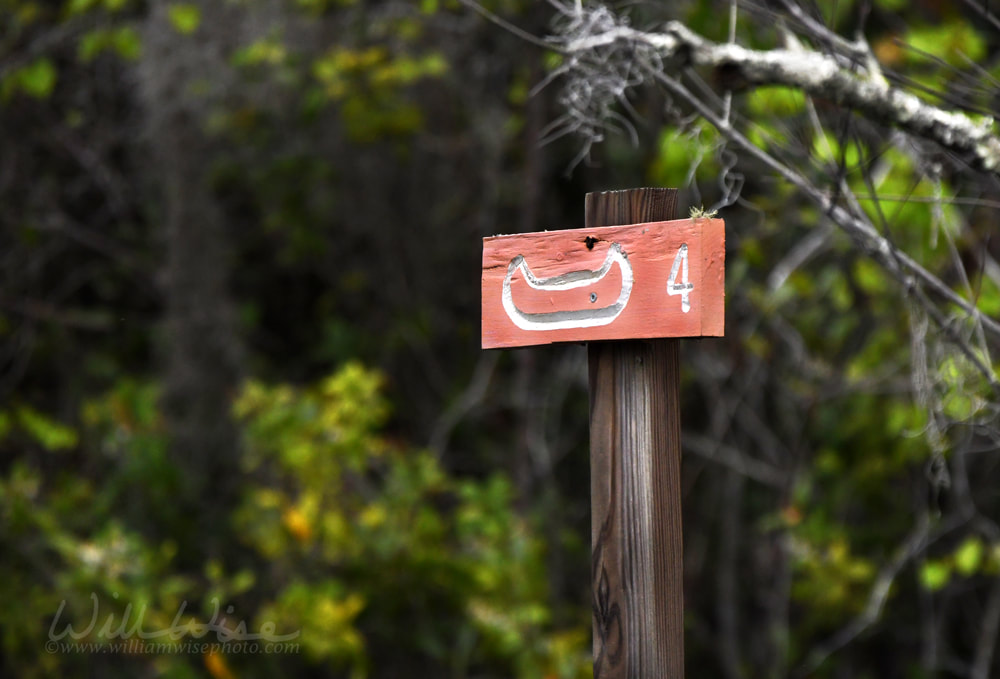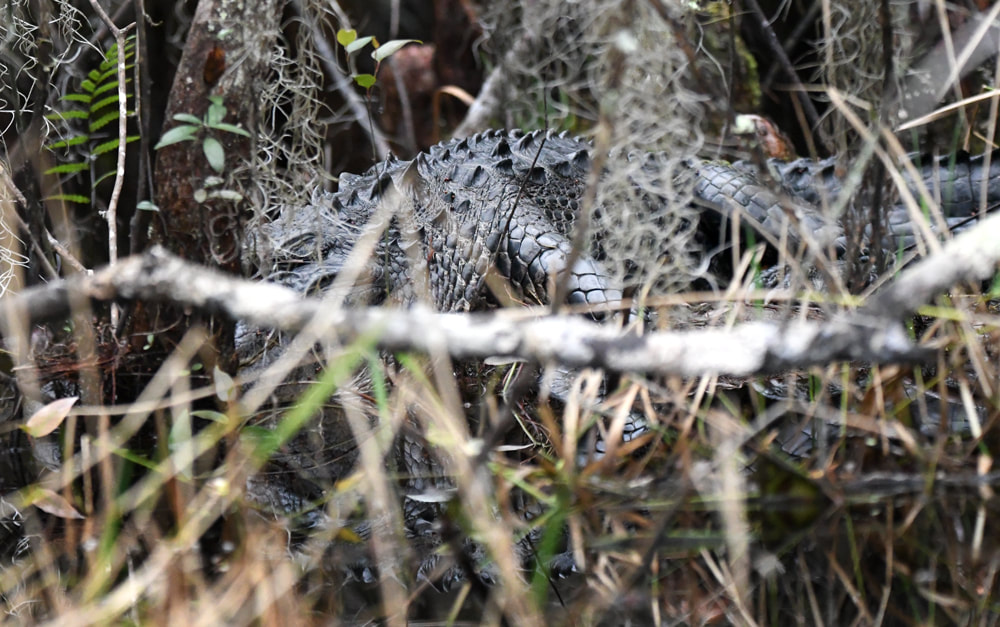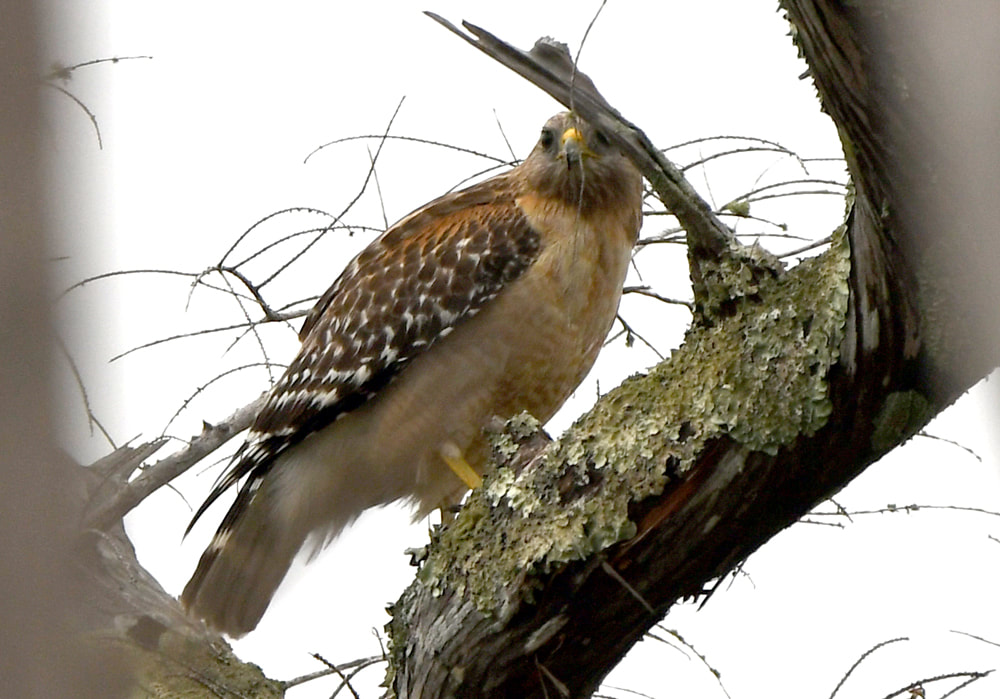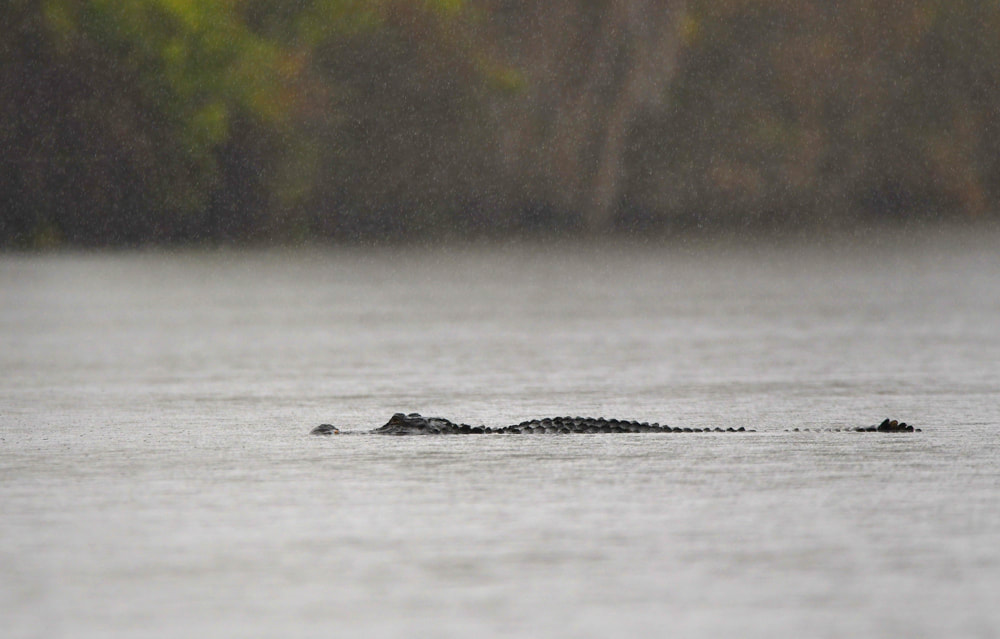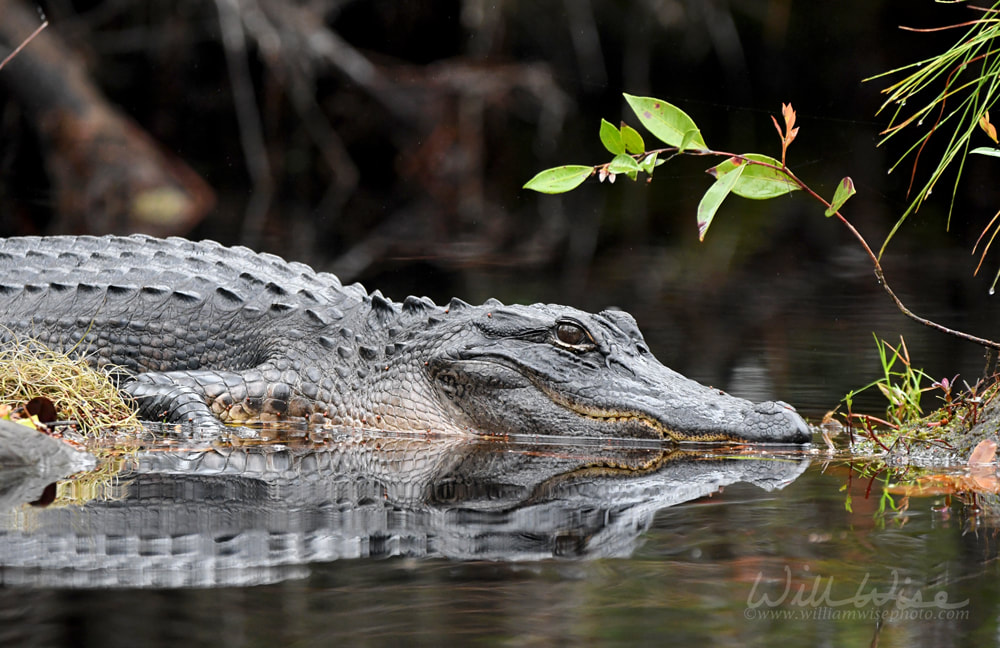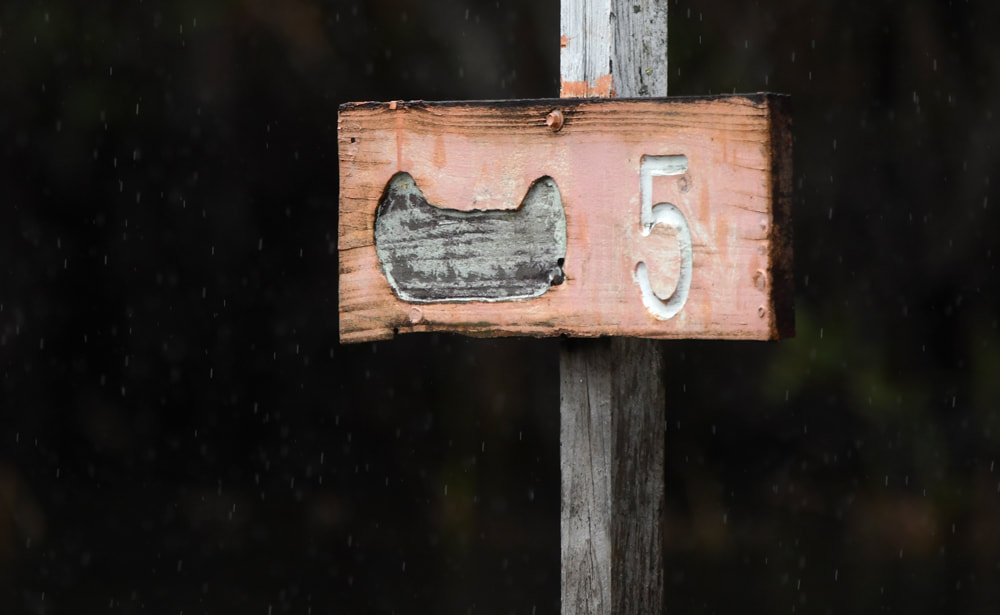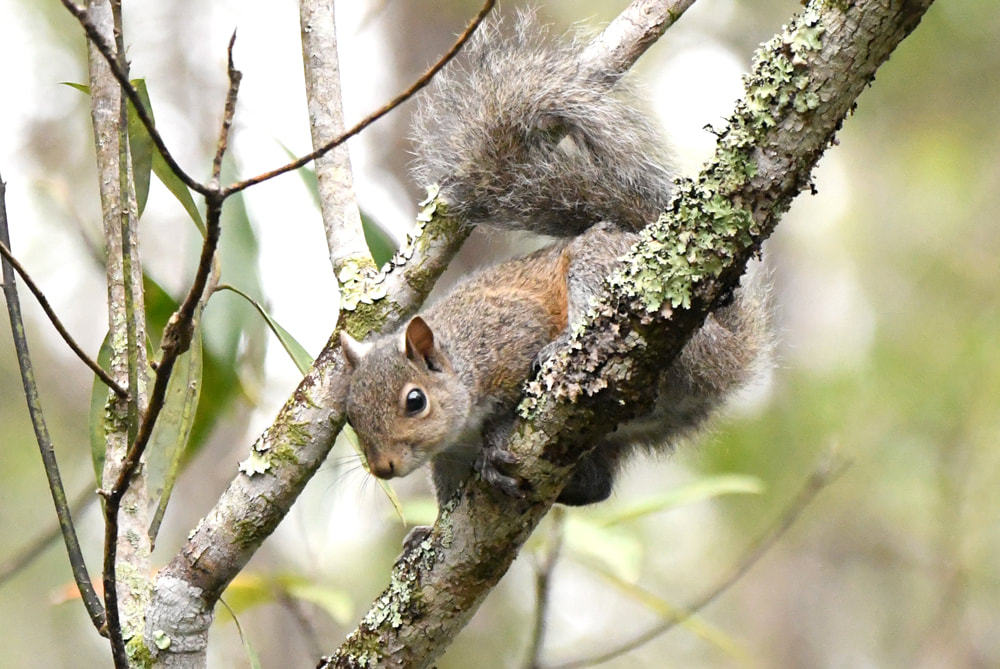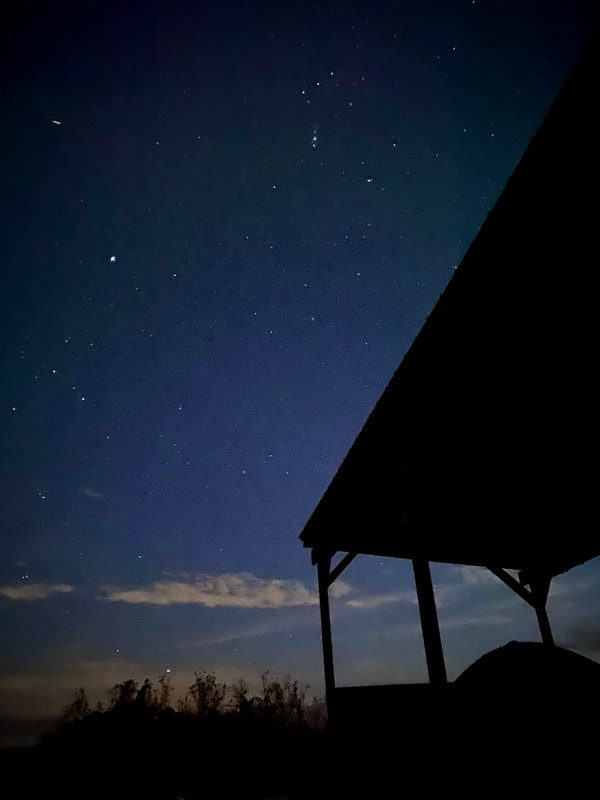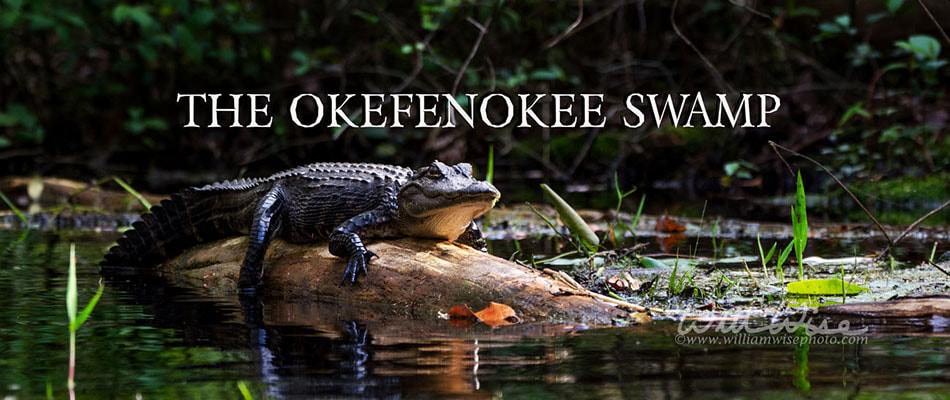 Okefenokee Photography by William Wise. A nature photo journal exploration of Georgia's Okefenokee Swamp, the Land of Trembling Earth, one of the largest blackwater swamps in North America. The alligators, birds, snakes and wildlife of Okefenokee National Wildlife Refuge. -- "What a wildly wonderful world, God! You made it all, with Wisdom at Your side, made earth overflow with your wonderful creations." Psalms 104 The Message Paddling and camping the Okefenokee Swamp is truly a wilderness experience. Everything you will need must be brought with you... and it all must fit it in the confines of a canoe and without capsizing it! Gear must be kept to a minimum. Of course, we have the essentials - oars and lifejackets are a must, and I never neglect my small Rx pouch of bandaids, allergy medicine, ibuprofen and a bee sting pen (which my daughter actually needed on our last paddle). Yes, there are toilets at the overnight platforms, and sometimes there is toilet paper, but I strongly recommend bringing some extra TP along with you! All of our snacks and meals must be able to be kept at air temperature, as there is no refrigerator on the canoe! An assortment of protein bars, trail mix, crackers and squirtable "cheese", peanut butter, bananas and a few other items fill our food bag. We bring a small propane stove to prepare our freeze-dried eggs and coffee for breakfast, and heat our camping meal each evening. Never forget trash bags to bring out all your refuse. Clothing is kept to a minimum (but nobody else is out there to catch our odor anyway!). Although I bring a toothbrush and deodorant, I gladly leave behind my razor. Needless to say, one can look like a true "Swamp Thing" when emerging from the Okefenokee after a few days.
The camping platforms are spacious, but you may have difficulty fitting several large tents on them. We bring a smaller 7' by 7' tent and our sleeping bags and tiny camping pillows. The only "unnecessary" comforts brought along are the canoe chairs and the thin camping pads to be used under our sleeping bags. Since photography is one of the primary purposes of my Okefenokee adventures, I have to keep room for that equipment. But that breakdown is an entirely separate blog. Even with the limited gear, the canoe can sit pretty low in the water.
0 Comments
 Okefenokee Photography by William Wise. A nature photo journal exploration of Georgia's Okefenokee Swamp, the Land of Trembling Earth, one of the largest blackwater swamps in North America. The alligators, birds, snakes and wildlife of Okefenokee National Wildlife Refuge. -- "What a wildly wonderful world, God! You made it all, with Wisdom at Your side, made earth overflow with your wonderful creations." Psalms 104 The Message Our final day came all too quickly. Thankfully the storms passed in the pre-dawn hours and the clouds dissipated as the sun rose. A cold front had passed through and the temperatures dropped and the wind increased as we paddled. The first leg of the journey back to civilization was along the short Blue Trail, just over two miles, that heads south from Floyd's Island until it meets with the Suwannee Canal (orange trail) that heads back to the Suwannee Canal Recreation Area where our vehicle was parked. After struggling out of the narrower trail just south of Floyd's Island, the blue trail comes into the open along the edge of Chase Prairie. The sun reflected across this beautiful prairie illuminating the bouquets of Golden Club and White Water Lily. I had to stop a few times to catch photos of the beautiful Southern Blue Flag Iris blooms. The alligators were also out enjoying the warmth of the rising sun, which hadn't shined for the last few days.  American Alligator peering from swamp grass and Golden Club on Chase Prairie in the Okefenokee Swamp. Okefenokee Swamp National Wildlife Refuge, Georgia. Reptile herping photography March 12, 2022 along the Suwannee Canal canoe trail near Chase Prairie between Floyd`s Island and the Canal Run Shelter Junction.  Okefenokee Photography by William Wise. A nature photo journal exploration of Georgia's Okefenokee Swamp, the Land of Trembling Earth, one of the largest blackwater swamps in North America. The alligators, birds, snakes and wildlife of Okefenokee National Wildlife Refuge. -- "What a wildly wonderful world, God! You made it all, with Wisdom at Your side, made earth overflow with your wonderful creations." Psalms 104 The Message The second day of our three-day overnight canoe paddle through the Okefenokee National Wildlife Refuge started with occasional rain and drizzle on Chase Prairie. We left Round Top shelter paddling towards Floyd's Island along the purple trail.  Okefenokee Photography by William Wise. A nature photo journal exploration of Georgia's Okefenokee Swamp, the Land of Trembling Earth, one of the largest blackwater swamps in North America. The alligators, birds, snakes and wildlife of Okefenokee National Wildlife Refuge. -- "What a wildly wonderful world, God! You made it all, with Wisdom at Your side, made earth overflow with your wonderful creations." Psalms 104 The Message After a rainy paddle across Chase Prairie on day two of our Okefenokee excursion, we crossed the intersection toward Bluff Lake and headed toward Floyd's Island, where we would be spending our second night.
After leaving the prairie, the channel closed in around us with a wall of shrubs and thickets on the left and right, and overhead stood a moderately tall forest of cypress, pine and bay. The waterway became so shallow, our oars often hit the peat in the blackwater, while the bottom of the canoe scraped over debris and fallen vegetation. The Green Trail was certainly green. Fresh spring growth on the trees and shrubs was made an even glossier green by the light rain. The thick floating carpets of sphagnum moss had a vibrant, viridescent glow. Emerald White Water Lily pads and Water Shield floated by on either side of our canoe. Here was a lush, green, living swampland!  Okefenokee Photography by William Wise. A nature photo journal exploration of Georgia's Okefenokee Swamp, the Land of Trembling Earth, one of the largest blackwater swamps in North America. The alligators, birds, snakes and wildlife of Okefenokee National Wildlife Refuge. -- "What a wildly wonderful world, God! You made it all, with Wisdom at Your side, made earth overflow with your wonderful creations." Psalms 104 The Message Just past 2 PM on the second day of our Okefenokee Swamp paddling adventure, we arrived at the bank of Floyd's Island. After setting up camp on the patio (it was bit too musty to sleep inside), we walked the island hoping to find some reptiles. But, alas, it was a bit too cool and rainy. However, we did find many other natural details of interest to post to iNaturalist.  Okefenokee Photography by William Wise. A nature photo journal exploration of Georgia's Okefenokee Swamp, the Land of Trembling Earth, one of the largest blackwater swamps in North America. The alligators, birds, snakes and wildlife of Okefenokee National Wildlife Refuge. -- "What a wildly wonderful world, God! You made it all, with Wisdom at Your side, made earth overflow with your wonderful creations." Psalms 104 The Message Obtaining permits to paddle the interior of the Okefenokee National Wildlife Refuge is a privilege. Because there are often many people seeking permits, and only one party is allowed at a time at each platform, the permits are often hard to come by. And because you have to call in advance to reserve your permit, this means the anticipation grows exponentially in the weeks prior to the trip. My daughter and I booked our three-day trip in early January 2022. Finally, on March 17, our launch day arrived! We checked in at the Okefenokee Adventures and put our canoe laden with camping gear into the waters of the Suwannee Canal on the eastern side of the Swamp. I can't fully express the elation I feel each time I push off solid ground and the canoe finally glides onto the smooth blackwater of the Okefenokee. I'm saturated with a calming satisfaction that I experience on very few other occasions.
 Okefenokee Photography by William Wise. A nature photo journal exploration of Georgia's Okefenokee Swamp, the Land of Trembling Earth, one of the largest blackwater swamps in North America. The alligators, birds, snakes and wildlife of Okefenokee National Wildlife Refuge. -- "What a wildly wonderful world, God! You made it all, with Wisdom at Your side, made earth overflow with your wonderful creations." Psalms 104 The Message Some may wonder why I have made so many trips to the Okefenokee National Wildlife Refuge. I'm in love. That's the simple answer. I'm in love with this great Swamp; in love with prairie landscapes, in love with the Cypress forests, in love with the jungle of vegetation, in love with the reptiles (even the dangerous ones!), and in love with the solitude of wilderness. As a conservation photographer, it is my goal to document the habitats and inhabitants in this place that I love so much. In March of 2022 my daughter and I made a three-day, two-night paddle from the Suwannee Canal entrance, to the Round Top shelter, to Floyd's Island and back. All along the way I tried to photograph as many of the Okefenokee's inhabitants as possible. It is always my desire to photograph a species that I haven't yet documented. And things started off well on this particular trip with the awkward call and photograph of a Fish Crow. The fish crow (Corvus ossifragus) is a species of crow found in the wetlands of the southeastern United States. Before I became a birder, I didn't even realize there were different species of crows. I just thought every black bird was a "crow". Just like the American Crow (Corvus brachyrhynchos) the Fish Crow is a heavy-billed, large black bird. The Cornell Lab of Ornithology states that the best way to distinguish the two species is by their call. "American Crows give full-throated "caw" notes in pairs, while Fish Crows are more nasal sounding, often giving short notes in pairs" (www.allaboutbirds.org). Most birders describe the Fish Crow's call as the negative exclamation "nuh uh". Although I don't think I can distinguish them 100%, I have American Crows around my house all year round. When the groups of Fish Crows show up, I can hear the difference in their calls. And this black beauty that sounded off during our launch in the Okefenokee sounded just like that stereotypical Fish Crow. So I was happy to get a photo of what many would say was "just another crow", and add the Fish Crow to my Okefenokee National Wildlife Refuge checklist. Okefenokee National Wildlife Refuge, Georgia. Three-day paddling trip from Suwannee Canal to Round Top to Floyd's Island.  Okefenokee Photography by William Wise. A nature photo journal exploration of Georgia's Okefenokee Swamp, the Land of Trembling Earth, one of the largest blackwater swamps in North America. The alligators, birds, snakes and wildlife of Okefenokee National Wildlife Refuge. -- "What a wildly wonderful world, God! You made it all, with Wisdom at Your side, made earth overflow with your wonderful creations." Psalms 104 The Message As my daughter and I paddled away from the Suwannee Canal launch area for our three-day overnight excursion into the Okefenokee Swamp in March 2022, our eyes scanned the banks for our first alligator spot of the day. Not too far up the channel we came across a fairly large gator half submerged among the Maidencane. But what caught my attention most was the bright red tag attached to its tail labelled “136”. This had to be an individual from a UGA research project! There is a lot of exciting research that has been going on for several years within the Okefenokee National Wildlife Refuge and the Okefenokee Swamp Park. Researchers from the University of Georgia have been capturing and tagging alligators and fitting some with satellite trackers. More and more on my recent trips to the Okefenokee, I have been excited to photograph one of the individuals involved in their studies. Spotting these tagged gators brings back memories of the trip that sparked my own alligator fascination back in the 1900’s! The tracking information is used to plot the alligators’ movements through the swamp and provide ideas about range sizes, the wanderings of males, the nesting habits of females, spatial ecology and habitat preference. You can even watch real-time tracks of these gators online! (https://www.ocearch.org/tracker/) The organic samples are also brought back to the lab for genetic and toxicology studies (https://www.facebook.com/UGACoastalEcologyLab/posts/356449716494430). To learn more about UGA’s studies or sponsor an alligator satellite tracker, see https://gail.uga.edu/giving/ecol/alligator-research-and-education  Okefenokee Photography by William Wise. A nature photo journal exploration of Georgia's Okefenokee Swamp, the Land of Trembling Earth, one of the largest blackwater swamps in North America. The alligators, birds, snakes and wildlife of Okefenokee National Wildlife Refuge. -- "What a wildly wonderful world, God! You made it all, with Wisdom at Your side, made earth overflow with your wonderful creations." Psalms 104 The Message The primitive conditions of the Okefenokee Swamp alone make it a challenging endeavor for a multi-night excursion. And if photography is one of your goals, advance planning is even more important. The watery environment of the Okefenokee requires extra precaution. Since blackwater swamps are slow and still, flipping your canoe or kayak in the Okefenokee isn't a threat to equipment. But a popup thunderstorm, especially in the spring, is always a high probability. My photo gear is kept in a rugged, watertight case. I always put my camera into the case when getting into, or out of the canoe. When out of its case, the camera strap is always around my neck while paddling, or attached to the canoe seat by a carabiner (I do the same for my binoculars and GPS). Obviously, there are no power outlets in the midst of the swamp to recharge those spent batteries and there are no camera stores to purchase extra memory cards. I bring 5 fully charged batteries on an extended trip. The less you use the LCD screen to view your photos, the longer the batteries last. So wait until you get home to go through the photos (they'll also be more of a surprise if you wait!). I also turn off the Bluetooth connection with my phone for geotagging the photos. Not only is the reception horrible in the swamp and cause incorrect tagging, but it is a huge drain on the batteries.
In addition to the camera and lenses, I keep some lens wipes, the rain cover, and polarizing filters in the case. I keep a spot empty for my binoculars and a backup battery for my iPhone. Some plastic bags and a small towel are also handy during light rainstorms. But if the rain is hard enough, just put the camera away and try to enjoy the landscapes without worrying over your camera!  Okefenokee Photography by William Wise. A nature photo journal exploration of Georgia's Okefenokee Swamp, the Land of Trembling Earth, one of the largest blackwater swamps in North America. The alligators, birds, snakes and wildlife of Okefenokee National Wildlife Refuge. -- "What a wildly wonderful world, God! You made it all, with Wisdom at Your side, made earth overflow with your wonderful creations." Psalms 104 The Message The first night of our three-day paddling excursion brought us to the Round Top Shelter. After paddling just over 8 miles on the Suwannee Canal, the junction of the purple canoe trail went off to our right and onto Chase Prairie. As we turned, the scene opened up onto a wide, beautiful prairie. The skies that had been overcast the entire day also opened up to a bright blue dome and an orange glowing sun lowering toward the horizon.  Okefenokee Photography by William Wise. A nature photo journal exploration of Georgia's Okefenokee Swamp, the Land of Trembling Earth, one of the largest blackwater swamps in North America. The alligators, birds, snakes and wildlife of Okefenokee National Wildlife Refuge. -- "What a wildly wonderful world, God! You made it all, with Wisdom at Your side, made earth overflow with your wonderful creations." Psalms 104 The Message In March 2022 my daughter and I made a three-day, two-night paddle from the Suwannee Canal entrance, to the Round Top shelter, to Floyd's Island and back. All along the way I tried to photograph as many of the Okefenokee's inhabitants as possible. Day 1 Suwannee Canal (ORANGE TRAIL), Start to Mile 2SUWANNEE CANAL (ORANGE TRAIL), MileS 2 to 4SUWANNEE CANAL (ORANGE TRAIL), MILE 4 TO 5SUWANNEE CANAL (ORANGE TRAIL) MILE 5 TO 6SUWANNEE CANAL (ORANGE TRAIL), MILE 6 TO 7SUWANNEE CANAL (ORANGE TRAIL), MILE 7 TO PURPLE TRAIL JUNCTIONThe only campground within the Okefenokee Swamp is at the Stephen C Foster State Park on the western side of the swamp. But if you want a wilderness camping experience within the interior of the Okefenokee, you’ll need a Wilderness Camping Permit. And during peak seasons, they can be a challenge to obtain.
The US Fish and Wildlife Service maintains a permit hotline to book overnight reservations. It may seem a bit primitive in our modern times to call on a telephone and speak to an actual person rather than book online, but the complexity warrants the current procedure. There are several overnight shelters within the refuge, and a few routes to reach each one. Availability is based on the number of nights you wish to paddle, the availability of overnight platforms, and the route you wish to take (i.e. point-to-point or out-and-back). Having a human being answer the phone truly helps schedule the best available routes. Exactly two months to the day prior to our March 2022 trip, I started ringing the line to the Okefenokee NWR permit hotline promptly at 7:00 AM. After a couple tries, the phone was answered by a cheery staff member! I told her our range of dates and basic plan. She then suggested one night on Round Top, and a second on Floyd's Island. I was quite excited to get that two-night permit and thankful to the staff member who helped arrange it. Just remember, call first thing in the morning and exactly two months prior to your planned trip.  Okefenokee Photography by William Wise. A nature photo journal exploration of Georgia's Okefenokee Swamp, the Land of Trembling Earth, one of the largest blackwater swamps in North America. The alligators, birds, snakes and wildlife of Okefenokee National Wildlife Refuge. -- "What a wildly wonderful world, God! You made it all, with Wisdom at Your side, made earth overflow with your wonderful creations." Psalms 104 The Message An evening and overnight at the Round Top Shelter on Chase Prairie; Okefenokee National Wildlife Refuge, Georgia.  Okefenokee Photography by William Wise. A nature photo journal exploration of Georgia's Okefenokee Swamp, the Land of Trembling Earth, one of the largest blackwater swamps in North America. The alligators, birds, snakes and wildlife of Okefenokee National Wildlife Refuge. -- "What a wildly wonderful world, God! You made it all, with Wisdom at Your side, made earth overflow with your wonderful creations." Psalms 104 The Message From our home in Athens, Georgia, the drive to the Okefenokee National Wildlife Refuge is about five hours. Even if we start early, it is mid-afternoon when we arrive. There typically isn’t enough time left in the day to go out on the water. So when visiting the eastern side of the Swamp at the Suwannee Canal entrance, as we did in March 2022, our first order of business is a drive along the Swamp Island Wildlife Drive.
This seven-mile drive winds through a beautiful landscape of upland Slash Pine and Saw Palmetto. With car windows down and the MPH at a near crawl, my eyes are always scanning for a Red-cockaded Woodpecker (one day!). Occasionally, Sandhill Crane walk down the middle of the paved drive, and juvenile alligators can always be spotted in the roadside borrow ditches. To the excitement of the first-time visitor, there is often an adult female alligator at the small pond along the roadway, and many times a larger gator basking roadside before reaching the loop.  Okefenokee Photography by William Wise. A nature photo journal exploration of Georgia's Okefenokee Swamp, the Land of Trembling Earth, one of the largest blackwater swamps in North America. The alligators, birds, snakes and wildlife of Okefenokee National Wildlife Refuge. -- "What a wildly wonderful world, God! You made it all, with Wisdom at Your side, made earth overflow with your wonderful creations." Psalms 104 The Message Excerpt from the 1875 Okefenokee Exploration by The Atlanta Constitution: "Now our knees began to feel weak, and tremble beneath the weight upon them; and indeed, we became so thoroughly exhausted that we trudged on and on, with the greatest indifference as to danger of any kind. At one time one of the party trod on a moccasin, and his comrade next behind called to him that he was on a snake, but he did not seem to care, and moved slowly on without looking back, and carelessly asked if he had hurt it! "This was an actual occurrence, and the man shudders now when he thinks of his own carelessness and of the danger of being bitten by that deadly serpent in that dismal wild far from home, and from physicians! If there were any objects of interest in this most hideous part of the swamp, I was too near “wearied unto death” to appreciate it. No, we longed to place our feet again upon terra firma, and our sole idea was to this end." - The Atlanta Constitution, September 23, 1875. In 1875, The Atlanta Constitution published the dramatic headline: “We now announce to our readers, and the people of Georgia, that we are fitting up an expedition for a complete and thorough exploration of Okefinokee. The full details of the plan and expedition will be published soon – if they come out alive.” Over the next months, the paper released many exciting stories from the Okefenokee Swamp. |
Categories
All
Archives
July 2025
|
|
All content is ©williamwisephoto.com. Please don't steal images. My images are available at dreamstime.com. Stock sales go into the shelter photography program.
|
In December 1993 I came to know the Designer and Creator of this wonderful planet and its creatures: Jesus Christ.
|
Donations help support the animal shelter adoption photography equipment and adoption website hosting and domain fees. Thanks for your support!
|





